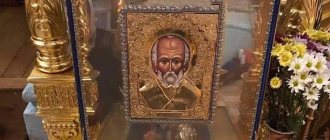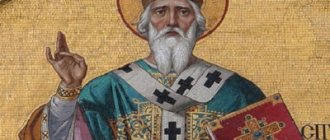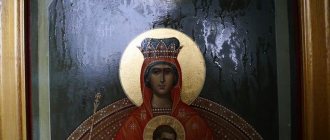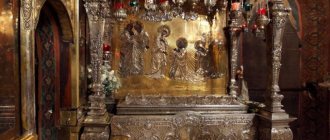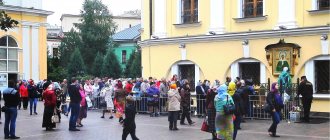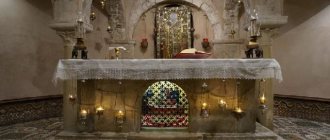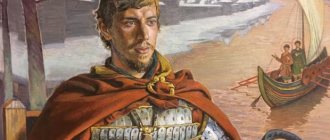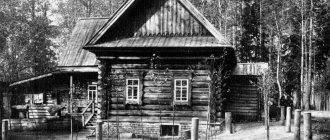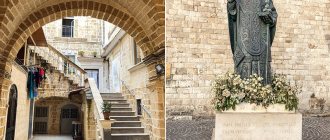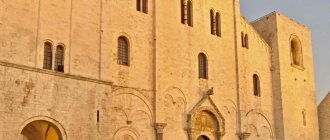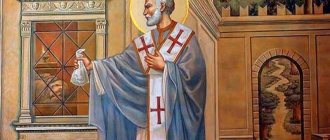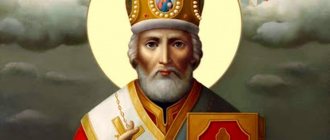Hello everyone, dear readers of the Moscow-Russia.rf blog. Today I want to continue the review of the churches of Moscow and today we will visit the temple in which there are the relics of Spyridon of Trimifuntsky, for those who do not know, this is a saint who helps all those who suffer, helping with material petitions. The most interesting thing is that the saint died a long time ago, his relics are kept in Greece, and every year the monks put on him new shoes, which wear out. They say that this is Saint Spyridon, he walks around the world and works for the good of people.
And so earlier I told how I visited the Church of the Matrona on Taganka, describing in detail the method of how best to get to the Intercession Monastery. This article will also be a similar atlas for guests and pilgrims.
Briefly about Saint Nicholas
A detailed life of the Miracle Worker of Myra was compiled by St. Dimitry Rostovsky. The saint was presumably born in 270 in the city of Patara (modern Türkiye). His parents were pious people, of noble origin and wealth. But wealth and high position did not harm them - they were merciful to those in need, believers, and prayers. For many years they prayed for the gift of a son, promising to dedicate the born child to the Lord. The merciful Lord heeded the prayers and gave the family a child.
Saint Nicholas is especially revered by the Russian Orthodox people
The son was baptized Nikolai. He was unlike other children: having excellent academic success, he did not waste time on empty conversations, avoided everything sinful, read Scripture for a long time and prayed. Over time, he was ordained as a reader, and later he became a presbyter.
The saint took part in the Ecumenical Council, denounced Arius and personally struck the wicked man on the cheek, defending Orthodoxy. During his earthly life, he served many people and the church.
prayers to Saint Spyridon of Trimythous
- prayer to Saint Spyridon of Trimythous for well-being
O blessed Saint Spyridon! Beg the mercy of God, the Lover of Mankind, not to judge us for our iniquities, but to deal with us according to His mercy. Ask us, God's servants (names), from Christ and God for our peaceful, serene life, mental and physical health. Deliver us from all spiritual and physical troubles, from all yearnings and the devil’s slander.
Remember us at the throne of the Almighty and beg the Lord to grant us forgiveness for many of our sins, grant us a comfortable and peaceful life, and grant us a shameless and peaceful death and eternal bliss in the future, so that we may continually send glory and thanksgiving to the Father and the Son and the Spirit Holy, now and ever, and unto ages of ages. Amen.
How to pray correctly > It is best to read the akathist to the saint for 40 days in a row, but not everyone can do this. But if you want something with all your heart and soul, then the whole universe will help you with it
You can also ask and pray, in your own words, most importantly from a pure heart, and ask and it will be given to you
Coming out of the Church of St. Spyridon, you will see on the opposite side a square where you can see a monument to an angel
And nearby is a monument to Rostropovich
This is how I had an interesting trip to the relics of Spyridon Trimifuntsky in Moscow, if you have any questions, please write in the comments.
History of the relics of the miracle worker
The saint was awarded a long life, and already in his old age he passed away in peace to the Lord. This happened around the year 342, according to the new style on December 19. The body of the deceased was buried in the temple, it remained incorrupt. An extraordinary fragrance emanated from him, an unearthly myrrh exuded.
Believers who worshiped the saint were healed of illnesses. This became widely known, and Christians from other cities and countries began to flock to the tomb to receive healing for diseases not only of the body, but also of the soul.
Burial place of the saint
The body of the saint, laid in the city temple in Myra of Lycia, remained in place until the 11th century. It is unknown when he was officially canonized, but people began to glorify him as a saint almost immediately after his death.
Currently, only ruins remind of the temple in Myra, where the saint rested. The city was renamed. Now it is called Demre and is located in what is now Turkey.
Broken tomb of St. Nicholas in Myra Lycia
Transfer of relics to Italy
In the XI century. Myra, as well as many Byzantine cities, came under Turkish rule. At the same time, the Italians from the city of Bari especially wanted to obtain the holy relics so that the saint would become the patron saint of their city. The events took place in 1087, after the Great Schism, which resulted in the formation of a Catholic organization that boldly called itself the church.
Catholics began to organize and conduct Crusades. Many people died under their swords. They stole the relics of the Miracle Worker of Myra and brought them to the city of Bari.
Despite the surviving historical facts of non-Christian behavior of Catholics, Italians like to tell a different story of the transfer of the shrine to their city. According to local residents, the saint appeared to a priest in a dream and ordered the relics lying in the city captured by the Turks to be taken to Europe. This legend raises a lot of questions, and above all, it reminds us of the attitude of the saint himself to heresy and his blow to the cheek of the wicked Arius. Italians annually remember the relocation of the shrine with a costumed carnival.
Relics of St. St. Nicholas the Wonderworker in the Basilica of Bari, Italy
Where are the relics of St. Nicholas now
Currently, the shrine is located in many cities and countries in the form of particles. In the Italian cities of Bari and Venice, crayfish with relics remained from the time of the Crusades, but these are only parts of them. There they rest permanently, only sometimes they can be transported to other places for worship. In addition to Italy, many pieces of relics are located in Russia.
In 2022, the relics were brought from Bari to Moscow. This event was a consequence of the signing of the declaration of St. Cyril and Pope Francis in 2016. The document became the starting point for accustoming the Orthodox to joint prayers with heretics and, as a result, their violation of the Apostolic and Council rules. In fact, there was no need for this action, since there are also parts of the relics of St. Nicholas the Pleasant in Russia. The relics were specially brought in a large shrine, as if the whole body rested in it. But only part of them rests in Italy.
The saint's memorial day is celebrated twice a year - on May 22 and December 19.
How to get to the Temple of Spyridon in Moscow
All of you can now imagine what kind of miracle this saint is, and that he helps everyone who asks him, without sparing his shoes he walks around the world. In this instruction, I will show you the easiest way to get to him and pray, and even ask the icon with his piece for the most cherished thing.
We will get there by metro, but if you have a car and can get there from another city, then you can easily use the navigator, the address will be below. The Temple of Spiridon itself is located in the center of Moscow, the closest way to it is from the Okhotny Ryad station, this is the red line.
If you are coming from the bottom (south), then at the Okhotny Ryad station you need to get out of the car and turn left, the signs will be towards Red Square, if from the north, then to the right after exiting the car. Take the medium sized escalators. Next, exit the metro doors and turn right. Get to the end and turn right again and go up the stairs.
You go out onto one of the main streets of Moscow, Tverskaya Street. You need to walk forward a couple of hundred meters . By the way, the Kremlin will be behind you :)
The relics of Spyridon Trimifuntsky in Moscow Tverskaya Street itself is entirely historical buildings, in each of which someone necessarily lived. I will not talk about everything, since this is not the topic of this article, I will only mention those that I meet along the way.
The first one will be the Yermolova Theater, if you saw it, go right.
road to the Relics of Spyridon Trimifuntsky in Moscow
Next you will see a beautiful building in which a lot of famous poets and scientists lived, there is also a McDonald's in it, I say this if you suddenly feel the urge due to human need, we are all people, and there you can do it for free and in comfortable conditions, I don’t know that everyone scolds them, but there is a positive side here.
road to the Relics of Spyridon Trimifuntsky in Moscow We continue to move forward, then there will be a lot of memorial plaques with famous people who lived on Tverskaya, you can highlight this entrance.
But the benches look so funny, be careful sitting on them in winter, you never know.
as a result, you should soon reach a giant arch, it will be on our left hand. You will see a sign for Bryusov Lane . Not named after Bruce Willis :).
We turn into it, that is, left.
And so we all got to Bryusov Lane, here is the temple with the relics of Spyridon of Trimifuntsky in Moscow. Bryusov Lane itself also consists of houses where a lot of famous people lived; you can find a lot of memorial plaques. Let's go forward, and you are almost visiting St. Spyridon.
Temple of Spyridon in Moscow
We’re getting even closer, unfortunately, I was here in the winter, it’s a little gloomy in Moscow, but in the spring I think it will be awesome here, I’ll definitely take you there with me in the spring.
Temple of Spyridon in Moscow
Next to the temple there will be a children's park, there will be such a wonderful monument in it, look for yourself.
The Temple of Spyridon itself has a more or less common form for Moscow.
Relics of Spyridon Trimifuntsky in Moscow
We go into the main entrance of the church.
Temple of Spyridon in Moscow
Address of the Temple of Spyridon in Moscow
And so here is the actual address of the Church of the Resurrection on the Assumption Enemy
Bryusov lane house 15/2 BUILDING 3
Temple of Spyridon in Moscow
And here is the date of foundation of the Church of the Resurrection on the Assumption Enemy. As you can see, it was built already in 1629, it will soon be 400 years old, it’s simply unthinkable.
Church of the Resurrection on the Assumption Enemy Walk forward into the depths of the temple. This is what the iconostasis looks like. I would like to note right away that I took all the photographs solely for the purpose of introducing you to the temple and maybe someone will find the photograph of the icon of Spyridon useful; not everyone has the opportunity to come. On the left there is a very powerful icon of the Mother of God, from whom many ask for their secret.
Here on the right are two icons, the one on the right with Christ, and on the left with a piece of the relics of Spyridon of Trimythous.
Temple of Spyridon in Moscow
There is a piece, right here
Temple of Spyridon in Moscow
Cities and churches of Russia, in which there are particles of the relics of St. Nicholas
In many monasteries in Russia the relics of the Wonderworker rest. There is no need to travel to other countries or enter into prayerful communication with heretics in order to be able to venerate them. In the Russian capital, the shrine can be found in the following monasteries:
- Danilov Holy Trinity Monastery, located at: Danilovsky Val, 22 (metro station "Tulskaya");
- Sretensky Stavropegic Monastery, which is located on the street. Bolshaya Lubyanka, 19;
- Ioanno-Predtechensky Convent, located at the address: Maly Ivanovsky lane, 2A, building 1;
- Novodevichy Convent, whose address is: Novodevichy Proezd, 1, building 2.
In addition to Moscow, shrines are kept in churches of other Russian cities:
- Saint Petersburg. St. Nicholas Naval Cathedral, located at: Nikolskaya Square, 1, bldg. 3;
- Saratov. St. Nicholas Monastery, whose address is: st. Degtyarnaya, 26;
- Rostov-on-Don. Holy Kazan Church, which is located on Avenue. Kosmonavtov, 16A, (Severny microdistrict);
- Ekaterinburg: Alexander Nevsky Novo-Tikhvin Convent, located on the street. Green Grove, 1.
Danilov Holy Trinity Monastery
Novodevichy Convent
John the Baptist Convent
Alexander Nevsky Novo-Tikhvin Convent
The shrine is “in circulation”?
Photo from the site onlinetambov.ru
- Today there are a lot of copies of shrines, for example, copies of the footprint of the Virgin Mary, the Holy Sepulcher. Doesn’t such replication of the sacred threaten piety? “Because there are many crosses, our attitude towards the Cross does not change. Copying is one of the ways of expressing meaning, a tool of human memory. Repetition for religious cultures is the most common form of such transfer of meaning. There are “exclusive” repetitions - the footprint of the Blessed Virgin Mary in Pochaev, on Mount Ascension, and other shrines associated with direct physical contact with the saint. But any icon is already a copy. The principle of copying was conceptualized at the Seventh Ecumenical Council (787).
Although one cannot but agree that there is a problem with reproducing shrines. We see calendars with icons hanging on every corner along with calendars with kittens.
But the main danger of devaluing a shrine is a lack of reverence towards it. If you cannot maintain healthy spiritual tension, attention and love for shrines, it is better not to venerate them, not to buy their image.
You need to balance your actions and your capabilities. After all, veneration of icons is also spiritual work. Icons are needed in order to pray to them. They make it possible to feel yourself in the presence of God, the Mother of God, and the saints. And if you do not feel the ability to pray to those icons that you have hung at home, it would be more pious to leave only those to which you pray, read the troparion, and place the rest one after another, than to ignore them altogether.
How to venerate holy relics
Orthodoxy does not dictate to believers strict rules for venerating shrines, because each soul understands independently how to venerate the relics. When worshiping the saint, people, at the behest of their hearts, make bows or bows to the ground, make the sign of the cross, and pray. The main thing is purity of heart, sincerity, faith in help. Usually the following features are observed during worship:
- believers do not crowd, do not jostle around the shrine;
- women do not come to shrines with makeup;
- bags are left in another place so that your hands are free;
- venerating the face of relics or icons is insolence.
You need to understand that a reliquary or reliquary is not just a “box”. Coming to the relics, a person approaches the saint himself and communicates with him.
When praying, one should avoid verbosity and sophistication. It is better to discard everything superficial and be simple, sincere, like a child.
Author's advice
Relics of St. Nicholas the Wonderworker
Orthodoxy gives believers absolutely everything for salvation. Many cities and churches in Russia currently house the relics of St. Nicholas the Wonderworker. Orthodox Christians can turn to their favorite saint for help and venerate his relics at any time.
If you find an error, please select a piece of text and press Ctrl+Enter.
“Orthodox paganism has been dissolved”
Pilgrims line up at the Cathedral of Christ the Savior to receive the gifts of the Magi.
Photo from the site rtvi.com - You can often hear accusations of paganism or magic from believers who are eager to venerate a shrine and consecrate some objects on it. Really, why bother? God won't hear otherwise?
“God will hear in another way.” One priest, who was on duty in the Cathedral of Christ the Savior during the stay of the Belt of the Virgin Mary, told me that healings were in the queue itself, that is, for those who had not yet touched the Belt, but were just getting ready. And there were more such healings than directly at the shrine.
But there is no paganism in the very desire to touch the shrine.
Is it possible to reproach a bleeding wife for paganism, who touched the Lord’s clothing and immediately received healing, and even praise from Him? (“Be of good cheer, daughter, your faith has saved you.” Matthew 9:20-22).
The shrine was left to us by God so that we could physically, and not just speculatively, mystically, spiritually, participate in communion with God.
God created the world from matter, sanctifying it with the spirit, our Savior was a God-man, the Church Itself is the Body of Christ - on this basis our attitude towards the shrine stands.
The nature of the shrine is based on the actions of those divine uncreated energies, about which St. Gregory Palamas said that they are not the Essence, but come from It.
These energies are present at every point in the historical existence of God and his saints. Actually, we call these points shrines.
For a believer, they remain sources of grace.
Saint John of Damascus wrote that “the saints were filled with the Holy Spirit during their lifetime, but when they died, the grace of the Holy Spirit is present both with their souls and with their bodies in the tombs, and with their figures, and with their holy icons - not essentially but by grace and action."
Relics of St. Sergius of Radonezh
St. Sergius of Radonezh is a miracle worker and perhaps the most revered saint of the Russian Orthodox Church. His role as an ascetic of Christianity was so great that in the middle of the 20th century even the Roman Catholic Church canonized him. Saint Sergius founded many monasteries (including the Trinity-Sergius Monastery, a stronghold of Russian spirituality) and inspired a galaxy of church leaders. It is difficult to overestimate his contribution to the unification of Russian lands. Miracles of healing and resurrection, reconciliation of warring parties and miraculous visions are associated with the name of the saint. He was canonized half a century after his death. The holy relics of Sergius of Radonezh rest in the Trinity-Sergius Lavra, where anyone can venerate them. As a miracle worker, they pray to him for healing, as a peacemaker - to pacify pride, as a defender of the righteous - they ask for protection on the eve of a lawsuit. According to legend, St. Sergius miraculously learned to read and write, and therefore he is also asked for help in comprehending the sciences.
Biography
The most revered saint in Orthodoxy, wonderworker, patron of sailors, travelers, orphans and prisoners. From the day of veneration of St. Nicholas the Wonderworker in December, the New Year holidays begin. Children expect Christmas gifts from him, because the saint became the prototype of Father Frost and Santa Claus. According to the life of the saint, he was born in 270 in the Lycian town of Patara, at that time a Greek colony. Today this is the territory of the Turkish provinces of Antalya and Mugla, and the area around Patara is called the vicinity of the village of Gelemish.
Icon of St. Nicholas the Wonderworker
The biography-life of Nicholas the Wonderworker says that his parents were wealthy Christians who gave their son an education befitting the 3rd century. The family of Nicholas of Myra (another name of the saint) were believers; his uncle, the Bishop of Patara, noticed his nephew’s religiosity and appointed him as a reader at public services.
Young Nicholas spent his days in the monastery, and devoted his nights to the study of the Holy Scriptures and prayers. The boy was amazingly responsive and realized early on that he would devote his life to serving Jesus Christ. The uncle, seeing his nephew’s diligence, took the teenager as an assistant. Soon Nicholas received priestly rank, and the bishop entrusted him with teaching lay believers.
Monument to Nicholas the Wonderworker in Yeisk
The young priest, having asked for the blessing of his uncle-bishop, went to the Holy Land. On the way to Jerusalem, Nicholas had a vision: the devil came onto the ship. The priest predicted a storm and the sinking of the ship. At the request of the ship's crew, Nicholas the Wonderworker pacified the rebellious sea. Having ascended Golgotha, the Lycian offered thanksgiving prayers to the Savior.
On a pilgrimage, he walked around the holy places and climbed Mount Zion. The doors of the temple, which was closed for the night, turned out to be a sign of the Lord’s mercy. Filled with gratitude, Nicholas decided to retire to the desert, but a voice from heaven stopped the young priest, telling him to return home.
Nicholas the Wonderworker at the patient's bedside
In Lycia, Nicholas joined the Brotherhood of Holy Zion to lead a silent life. But the Almighty and the Mother of God appeared to him and handed him the Gospel and the omophorion. According to legend, the Lycian bishops received a sign, after which they decided at a council to make the young layman Nicholas bishop of Myra (a city in the Lycian Confederation). Historians and religious scholars argue that the appointment was possible for the 4th century.
Monument to Nicholas the Wonderworker in Demre
After the death of his parents, Nicholas entered into inheritance rights and distributed the wealth due to him to the poor. The ministry of the Bishop of Myra of Lycia fell during difficult times of persecution. The Roman emperors Diocletian and Maximian persecuted Christians, but in May 305, after the imperial abdication, Constantius, who took the throne, stopped the persecution in the western part of the empire. In the east they continued until 311 by the Roman Emperor Galerius. After a period of oppression, Christianity in Myra Lycia, where Nicholas was bishop, developed rapidly. He is credited with the destruction of pagan temples and the temple of Artemis in Myra.
Nicholas the Wonderworker
Researchers of the life of Nicholas the Wonderworker talk about the cathedral court at which he was subjected to trial. The Greek Metropolitan of Nafpaktos, in his book “Treasure,” claims that the future saint was tried for slapping Arius during the Council of Nicaea. But researchers tend to consider a slap as slander. They say that Nicholas called the heretic a “mad blasphemer,” for which he became the object of a conciliar trial. Those slandered resort to the help of the Wonderworker Nicholas, since it is believed that the saint will save them from their sad fate.
Patron of travelers and favorite wizard
Saint Nicholas, popularly called Nicholas the Wonderworker and Nicholas the Pleasant, is revered in the Orthodox, Catholic, Lutheran and Anglican churches. He was born in the 3rd century in the seaside town of Patara in Lycia, on the outskirts of the Byzantine Empire. Nicholas was raised by rich and noble parents.
In his youth, he and his family moved to the port city of Myra, where he lived all his life. Nicholas performed miracles during his lifetime: he saved drowning sailors, healed the sick, helped the poor, and was cordial and merciful to the people around him. For this they began to call him the Wonderworker.
One of the most revered saints became the patron saint of sailors, travelers and children. It is no coincidence that the saint served as the prototype of the modern Santa Claus. According to legend, one rich but bankrupt man, in despair, almost sold his three daughters to a brothel.
Having learned about this, the saint secretly threw three bags of gold into the window of his house and thereby saved the family from ruin. One of these bags accidentally ended up in one of the girls’ stockings, which was lying on the floor. It was after this that the tradition arose in Europe of hanging stockings at the head of the bed in anticipation that St. Nicholas would put gifts in them.
At the beginning of the 17th century, the Dutch, who revered St. Nicholas, founded the colony of New Amsterdam in America - modern New York. In their pronunciation, Sinterklaas began to be called Santa Claus.
By the end of the 19th century, the legend and tradition of giving gifts to children on St. Nicholas’s name day came from Europe to Russia. In Rus', Nikolin's day was a day off and was celebrated especially solemnly. People with their whole families went to church for the liturgy, after it they gathered for dinner at the festive table, and then held mass festivities on the winter streets.
